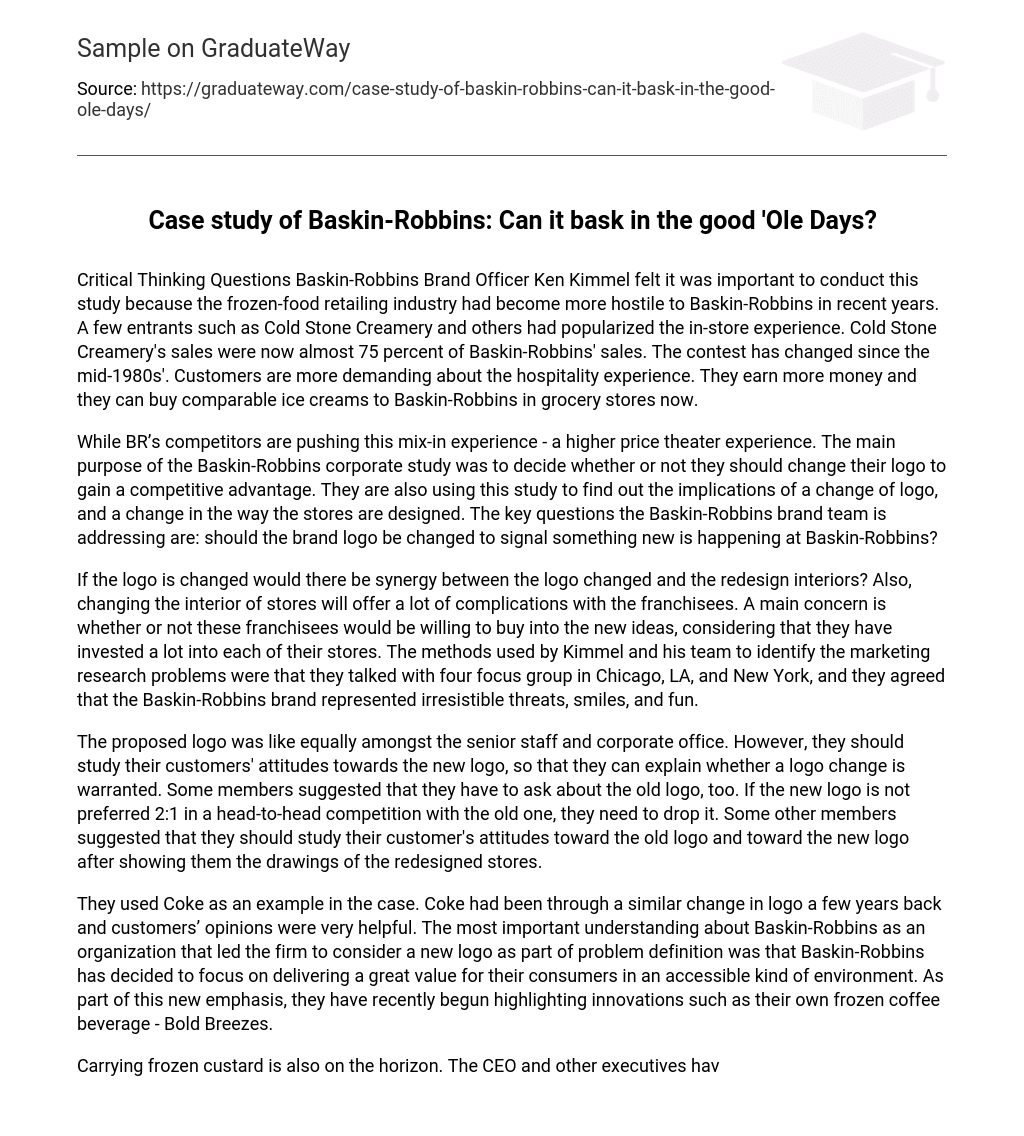Critical Thinking Questions Baskin-Robbins Brand Officer Ken Kimmel felt it was important to conduct this study because the frozen-food retailing industry had become more hostile to Baskin-Robbins in recent years. A few entrants such as Cold Stone Creamery and others had popularized the in-store experience. Cold Stone Creamery’s sales were now almost 75 percent of Baskin-Robbins’ sales. The contest has changed since the mid-1980s’. Customers are more demanding about the hospitality experience. They earn more money and they can buy comparable ice creams to Baskin-Robbins in grocery stores now.
While BR’s competitors are pushing this mix-in experience – a higher price theater experience. The main purpose of the Baskin-Robbins corporate study was to decide whether or not they should change their logo to gain a competitive advantage. They are also using this study to find out the implications of a change of logo, and a change in the way the stores are designed. The key questions the Baskin-Robbins brand team is addressing are: should the brand logo be changed to signal something new is happening at Baskin-Robbins?
If the logo is changed would there be synergy between the logo changed and the redesign interiors? Also, changing the interior of stores will offer a lot of complications with the franchisees. A main concern is whether or not these franchisees would be willing to buy into the new ideas, considering that they have invested a lot into each of their stores. The methods used by Kimmel and his team to identify the marketing research problems were that they talked with four focus group in Chicago, LA, and New York, and they agreed that the Baskin-Robbins brand represented irresistible threats, smiles, and fun.
The proposed logo was like equally amongst the senior staff and corporate office. However, they should study their customers’ attitudes towards the new logo, so that they can explain whether a logo change is warranted. Some members suggested that they have to ask about the old logo, too. If the new logo is not preferred 2:1 in a head-to-head competition with the old one, they need to drop it. Some other members suggested that they should study their customer’s attitudes toward the old logo and toward the new logo after showing them the drawings of the redesigned stores.
They used Coke as an example in the case. Coke had been through a similar change in logo a few years back and customers’ opinions were very helpful. The most important understanding about Baskin-Robbins as an organization that led the firm to consider a new logo as part of problem definition was that Baskin-Robbins has decided to focus on delivering a great value for their consumers in an accessible kind of environment. As part of this new emphasis, they have recently begun highlighting innovations such as their own frozen coffee beverage – Bold Breezes.
Carrying frozen custard is also on the horizon. The CEO and other executives have discussed the changes thoroughly throughout the case. There have also been investments made into consultants to get a bird eye’s view of the company’s operations. An analyst in the quick-service restaurant industry have reported in the trade journals that the new entrants had continued to grow faster than Baskin-Robbins’ especially in the key of same-store sales compared to the previous year. The series of marketing research problem statements can be put into context by speaking simpler.
Baskin-Robbins wants to change the way their store and logo look in order to gain an edge over the other ice cream places. They also want the logo and new design of the store to reflect their agenda. They want to appeal to the customer in the best way possible, and conducting the research will allow Baskin-Robbins to do just that. The main inference implied in this case pertaining to problem definition is that Baskin-Robbins needs a change in order to compete. They are an established brand with thoughts of remodeling and reconstruction of the logo.
Cold Stone-Creamery and new entrants are extremely threatening to a brand that has been around for a long time. Steps must be taken towards a change in the image of the company if they want to continue to compete at a high lvevel. If we take this line of reasoning seriously, the implications for many others firms seeking to define the marketing research problem related to rebranding are :Is an established brand that the logo for should not be overhauled? Should the brand logo be changed to signal something new is happening at Baskin-Robbins?
If the logo is changed would there be synergy between the logo changed and the redesign interiors? If more companies and competitors took this line of reasoning seriously, then Baskin-Robbins would not be as successful. Cold-Stone appeals more to the younger crowd because of the theatrical experience and fun for young people. If Cold-Stone decided to focus more on the value of the product, rather than the theatrics, then Baskin-Robbins could either benefit or be destroyed. Baskin-Robbins is just trying to differentiate itself from the competition with this new plan.





